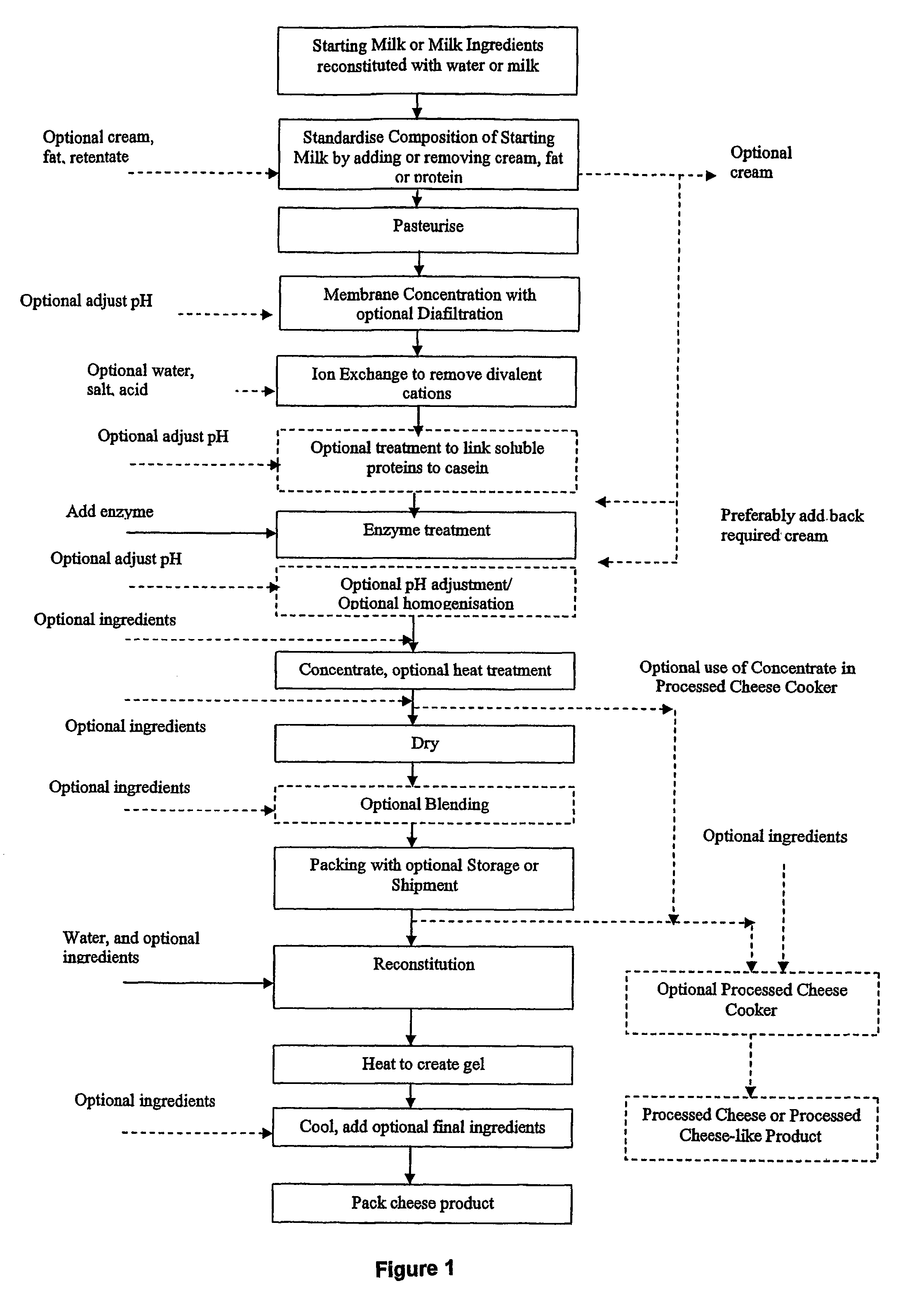Process for preparing concentrated milk protein ingredient and processed cheese made therefrom
a technology of concentrated milk protein and processed cheese, which is applied in the field of preparation of concentrated milk protein ingredient and processed cheese made therefrom, can solve the problems of difficult concentration efficiency, difficult incorporation of water into the ingredients, and practical and economic limitations of the use of these agents
- Summary
- Abstract
- Description
- Claims
- Application Information
AI Technical Summary
Problems solved by technology
Method used
Image
Examples
example 1
Manufacture of High Fat Low Calcium and Renneted Ingredient
[0093]Three 25 kg bags of commercial milk protein concentrate (MPC85, ALAPRO™ 4850) were reconstituted in 50° C. water to 9% total solids. The reconstituted solution was cooled to 10° C. The cooled solution was then pH adjusted to 5.85 with 3% lactic acid solution.
[0094]Ion Exchange
[0095]The cooled pH adjusted MPC85 solution was passed through a column containing 100 L of RHOM & HAAS ion exchange resin SR1LNa to reduce the calcium concentration. Following at least 90% calcium removal, 196 kg of (40% fat) cream was added to the ion-exchanged MPC85 solution. The calcium to protein ratio of the mixture was 3,320 mg / kg (1300 mg / kg powder basis of Table 1). This corresponds to a removal of approximately 90% of the calcium that was present in the starting milk.
[0096]Cold Renneting
[0097]The mixture was renneted cold. Australian Double Strength rennet was added at a rennet to protein ratio of 0.25% to the calcium depleted, cream for...
example 2
Efficacy of Renneting (Comparative)
[0100]Renneted solution (from example 1) was heated to 50° C. and held for 1 hour to ensure that the reaction had gone to completion. No sign of precipitation or formation of a gel was observed. To a second sample, calcium chloride solution was added in sufficient quantity to precipitate the protein. On heating the precipitate in hot water (50° C.) the precipitate firmed to a stretchy mozzarella type consistency indicating that the ion exchanged retentate had undergone sufficient renneting (in the process of example 1) to form a cheese gel but for the absence of sufficient calcium and heat. When the same test was carried out on non-renneted ion-exchanged retentate the precipitate formed was fine, non-cohesive and did not possess a gel-like texture.
example 3
Hot Renneting
[0101]Although milk is commonly treated with rennet as a batch process, effective renneting at temperatures elevated above those commonly used in cheese manufacture would enable a continuous process to be used for the renneting, concentration and drying stages of the desired process.
[0102]A 20% w / w solution of commercial medium calcium depleted MPC85 powder (NZMP 4861) (approximately 12,800 mg Ca / kg powder i.e. approximately 50-60% of the calcium removed) was reconstituted by mixing the powder in water with an overhead stirrer for 30 minutes at 50° C. The calcium to protein ratio of the solution was 15,100 mg / kg.
[0103]A sample of the reconstituted solution was taken and calcium chloride solution was quickly added in sufficient quantity to precipitate the protein. The precipitate was immediately washed in hot water (50° C.). After washing, the texture of the precipitate was fine, non-cohesive and did not possess a gel like structure.
[0104]To the remainder of the solution...
PUM
 Login to View More
Login to View More Abstract
Description
Claims
Application Information
 Login to View More
Login to View More - R&D
- Intellectual Property
- Life Sciences
- Materials
- Tech Scout
- Unparalleled Data Quality
- Higher Quality Content
- 60% Fewer Hallucinations
Browse by: Latest US Patents, China's latest patents, Technical Efficacy Thesaurus, Application Domain, Technology Topic, Popular Technical Reports.
© 2025 PatSnap. All rights reserved.Legal|Privacy policy|Modern Slavery Act Transparency Statement|Sitemap|About US| Contact US: help@patsnap.com

